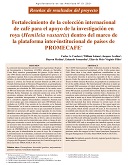| dc.contributor.author | Cordero, Carlos A. | |
| dc.contributor.author | Solano, William | |
| dc.contributor.author | Avelino, Jacques | |
| dc.contributor.author | Medina, Bayron | |
| dc.contributor.author | Somarriba, Eduardo | |
| dc.contributor.author | Virginio Filho, Elias de Melo | |
| dc.date.accessioned | 2021-08-03T02:03:07Z | |
| dc.date.available | 2021-08-03T02:03:07Z | |
| dc.date.issued | 2021 | |
| dc.identifier.uri | https://repositorio.catie.ac.cr/handle/11554/11142 | |
| dc.description | 5 referencias, 4 páginas, 1 figura. | es_ES |
| dc.description.abstract | La colección internacional de café del Centro Agronómico Tropical
de Investigación y Enseñanza (CATIE), ubicada en Turrialba,
Costa Rica, conserva germoplasma del género Coffea desde el
año 1949. Desde entonces ha realizado significativos aportes a la
caficultura regional. Esta es una colección de importancia mundial
debido a la diversidad genética que conserva, especialmente de la
especie C. arabica. En virtud del acuerdo firmado en 2006, con el
Tratado Internacional de Recursos Fitogenéticos, su germoplasma
es considerado de dominio público. La colección internacional está
compuesta por alrededor de 2000 accesiones de las cuales cerca
de 800 son materiales silvestres colectados en su centro de origen
(Etiopía, Kenia. Tanzania). La colección cuenta con cerca de 900
accesiones antiguas derivadas del Typica y Bourbon, así como
algunas variedades introgresadas o resultantes de un retrocuce
de C. canephora, algunas seleccionadas y mutantes. Además, hay
un tercer grupo que está compuesto por unos 180 híbridos desa rrollados en CATIE. Una sección de la colección es la llamada
“Diferenciales” en la cual se conservan los materiales que presen tan tolerancia a ciertas razas de roya y que reaccionan de manera
diferente en presencia del agente causal, logrando de esta forma
identificar razas del patógeno. Debido a la edad de las plantas que
en su mayoría sobrepasa los 50 años, fue necesario reestablecer y
reubicar toda la colección. Para ello, se llevó a cabo un inventario
para conocer cuales son los materiales que están en riesgo de pér dida para rescatarlos a través de la injertación y así restablecerlos
en un nuevo sitio. Esta labor permitirá tener mayor disponibilidad
de material genético para ser distribuido a los países que forman
parte de PROMECAFE y fortalecer la capacidad instalada en
cada país para la identificación de razas de roya. En el simposio
Latinoamericano de Caficultura, realizado en Guatemala en el año
2019, se presentaron los avances y estrategias de colaboración en
el marco de la plataforma regional de roya del café, que cuenta con
el apoyo del Programa Centroamericano de Gestión Integral de la
Roya del Café -PROCAGICA-IICA-UE. | es_ES |
| dc.description.abstract | The CATIE International Coffee Collection located in Turrialba,
Costa Rica has conserved germplasm of the Coffea genus since
1949. Since then it has made significant contributions to the
regional coffee farming. This collection is of world importance due
to the genetic diversity it preserves, especially of the C. arabica
species. Under the agreement signed in 2006, with the International
Treaty on Plant Genetic Resources, its germplasm is considered to
be of the public domain. The International Collection is made up
of around 2000 accessions of which about 800 are wild materials
collected at its center of origin (Ethiopia, Kenya, Tanzania). It has
about 900 ancient accessions derived from Typica and Bourbon, as
well as introgressed or resulting varieties from a backcross of C.
canephora, some selections and mutants. In addition, there is a third
group that is made up of about 180 hybrids developed at CATIE.
One section of the collection is the so-called “Differentials” in
which the materials that show tolerance to certain races of rust
and that react differently in the presence of the causal agent are
conserved, thus identifying races of the pathogen. Due to the age
of the plants, which mostly exceeds 50 years, it was necessary to
reestablish and relocate the entire collection. For this, an inventory
was carried out to find out which materials are at risk of loss in
order to rescue them through grafting and thus reestablish them in
a new site. This work will make possible to have greater availability
of genetic material to be distributed to the countries that are part
of PROMECAFE and to strengthen the installed capacity in each
country for the identification of rust races. At the Latin American
Coffee Symposium, held in Guatemala in 2019, progress and col laboration strategies were presented for the regional coffee rust
platform, under the support of the Central American Program for
Integral Management of Coffee Rust PROCAGICA-IICA-EU. | |
| dc.language.iso | es | es_ES |
| dc.publisher | CATIE, Turrialba (Costa Rica) | es_ES |
| dc.relation.ispartof | Agroforestería en las Américas Número 51 (2021), páginas 103-106 | |
| dc.rights | info:eu-repo/semantics/openAccess | es_ES |
| dc.subject | ROYA | es_ES |
| dc.subject | DIVERSIDAD | es_ES |
| dc.subject | GENOTIPOS | es_ES |
| dc.subject | VARIEDADES | es_ES |
| dc.subject | HEMILEA VASTATRIX | es_ES |
| dc.subject | CAFE | es_ES |
| dc.subject | COLECCIONES | es_ES |
| dc.subject | INVESTIGACION | es_ES |
| dc.title | Fortalecimiento de la colección internacional de café para el apoyo de la investigación en roya (Hemileia vastatrix) dentro del marco de la plataforma inter-institucional de países de PROMECAFE | es_ES |
| dc.type | Artículo | es_ES |
| dc.journal.issueNumber | 51 | |


